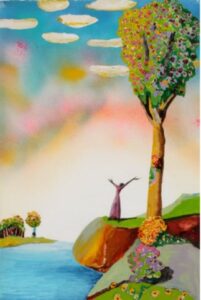Silver Linings: Celebrating the Spelman Art Collection
Audio Guide
Introduction
Audio Recording
Silver Linings: Celebrating the Spelman Art Collection
Silver Linings highlights the artworks of masters, pioneers, and trailblazers who anchor the Spelman collection. The 39 artworks in the exhibition represent a variety of mediums and techniques including painting, drawing, sculpture, mixed-media collage, prints, and photographs. The artworks are divided into five sections that focus on the Spiral Group, early figuration, abstraction, contemporary photography, and contemporary figuration.
The exhibition features artworks by a range of artists including Amalia Amaki, Emma Amos, Benny Andrews, Firelei Báez, Herman “Kofi” Bailey, Romare Bearden, Betty Blayton, Beverly Buchanan, Selma Burke, Elizabeth Catlett, Floyd Coleman, Renee Cox, Myra Greene, Sam Gilliam, Glenn Ligon, Howardena Pindell, Lucille Malkia Roberts, Deborah Roberts, Faith Ringgold, Nellie Mae Rowe, Lorna Simpson, Henry Ossawa Tanner, Lina Iris Viktor, Carrie Mae Weems, Charles White, and Hale Woodruff.
Silver Linings: Celebrating the Spelman Art Collection is organized by Spelman College Museum of Fine Art, Atlanta, Georgia and curated by Liz Andrews and Karen Comer Lowe with initial contributions from Anne Collins Smith. Wall text and labels were written by Charmaine Branch, Vassar class of 2014.
Founded in 1881 as the Atlanta Baptist Female Seminary, Spelman College has long been an important cultural hub. The historically Black liberal arts college for women began collecting objects in 1899, and in 1996 the Spelman College Museum of Fine Art opened with the mission to uplift art by and about women of the African diaspora. This goal directly reflects Spelman College’s dedication to academic excellence in education of women of African descent. In honor of the museum’s 25 years and the college’s much longer legacy of collecting art, the Spelman College Museum of Fine Art organized the anniversary exhibition Silver Linings with a selection of works from the 1900s until now from the permanent collection.
Silver Linings: Celebrating the Spelman Art Collection is organized by Spelman College Museum of Fine Art, Atlanta, Georgia
Curated by Liz Andrews and Karen Comer Lowe with initial contributions from Anne Collins Smith
Support provided by Art Bridges Foundation
Edna Manley, Market Women, 1936
Audio Recording
Edna Manley
Jamaican, b. England 1900–1987
Market Women, 1936
Mahogany
Gift of Elsie Myers
The elegant, angular bodies of the two figures in Market Women are indicative of Edna Manley’s sculptural style, with rounded forms sculpted out of wood and stone. Her earlier works had a more geometric appearance, but no matter the style in which she was working, Manley always took inspiration from her surroundings in Jamaica. Manley would frequently visit the Kingston marketplace, where she engaged with women socializing and selling goods. The works these encounters inspired took on two identities. They were both studies of individual persons and visual representations of a national spirit that spoke to the experiences of the Jamaican people. “I carve as a Jamaican for Jamaica, trying to understand our problems and living near to the heart of our people,” she stated in an interview. Born in England to a Jamaican mother of multi-racial ancestry and an English father, Manley married her cousin Norman Manley and moved to Jamaica with him in 1922.
She helped to establish a flourishing art scene in Kingston and played a role in the country’s politics by supporting her husband’s agenda as the first Premier of Jamaica. The couple advocated for universal suffrage for all Jamaican people and, in 1950, Edna Manley co-founded The Jamaican School of Art. She created several monumental public sculptures that can be found throughout Kingston in addition to smaller works like Market Women.

Charles White, John Brown, 1938
Audio Recording
Charles White
American, 1918–1979
John Brown, 1938
Graphite on paper
Gift of George Wein in honor of his wife, Joyce Wein
Charles White created at least two drawings and one print of the abolitionist John Brown during his career. Each one has certain stylistic differences that demonstrate the range of technical expertise that White cultivated while studying art in Chicago, where he was a prominent member of the Black artist community. He defined the thematic focus of his practice as the “Black experience,” and frequently celebrated Black individuals who shaped American society as well as prominent white anti-slavery advocates like Brown. In his search for visual imagery that elevated the wellbeing of his community, White took inspiration from many sources, including his travels with his first wife, artist Elizabeth Catlett to Mexico City, where he learned from renowned Mexican muralists and printmakers. He did not shy away from the political possibilities of art, noting, “The fact is, artists have always been propagandists. I have no use for artists who try to divorce themselves from the struggle.”
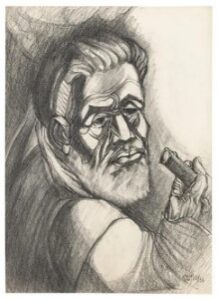
Section Topic: Spiral Group
Audio Recording
Spiral Group
In 1963, artists Charles Alston, Romare Bearden, Norman Lewis, and Hale Woodruff came together in New York City to form the artist collective Spiral with the initial intention of traveling to the March on Washington. Silver Linings includes works by founding members Bearden and Woodruff, as well as Emma Amos, who joined the collective in 1964. For two years, the Spiral members met regularly to discuss topics such as the value of abstraction in painting and the obligations of Black artists to the ongoing Civil Rights Movement. When Woodruff invited Amos to participate in the gatherings, she was the youngest member and the only woman accepted into the collective. Before Amos began attending meetings, Faith Ringgold—who is also featured in Silver Linings—wrote to Bearden inquiring about joining Spiral but did not receive an invitation even though her activism and art aligned with their mission. Later in life, Amos commented that it was “fishy” that the Spiral members had not asked “any other women of their acquaintance to join,” and cited Ringgold as one such artist who should have been welcomed into the group. Even after Spiral dispersed in 1965, the collective’s conversations continued to have an impact on each artist’s career.
Romare Bearden, Early Morning, 1964
Audio Recording
Romare Bearden
American, 1911–1988
Early Morning, 1964
Mixed Media
Gift of Catherine and Chauncey Waddell
In Early Morning, three figures come to life through Romare Bearden’s use of collage. Each face takes on a unique appearance, with juxtaposing realistic and abstract features, while the interior setting is made visible through the presence of several domestic objects. Early Morning is one of Bearden’s earliest collages, which he began making in 1964. He called these compositions “Projections” in reference to his process of creating small-scale works which he then turned into large-scale photo reproductions. The idea for this technique first came to him at a meeting of the artist collective Spiral, when he suggested that the group design a collage together. Ultimately, he was the only person interested, and he utilized source material from the Black culture magazines Jet and Ebony to see the project through. Bearden considered the act of combining painting techniques and the photographic image to be a “breaking of convention” from traditional forms of art making. This revelatory experience deeply influenced the trajectory of his career, and he continued to produce “Projections” throughout his life.
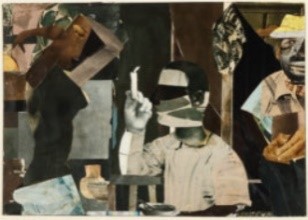
Hale Woodruff, Celestial Gate, 1953
Audio Recording
Hale Woodruff
American, 1900–1980
Celestial Gate, 1953
Oil on canvas
Gift of Catherine and Chauncey Waddell
Celestial Gate is part of a series by the same name that Hale Woodruff developed through his study of West African art. The painting references two African cultures. It features a door designed similarly to a Dogon granary door and decorated with symbols inspired by Asante (also spelled Ashanti) gold weights. The Dogon people, who are indigenous to West Africa, traditionally decorate granary doors with illustrations of their cosmological beliefs, including the origins of life. Indigenous to the contemporary region of Ghana, the Asante people mold gold weights into geometric and figurative forms that reference everything from historical events to popular myths. Woodruff described the artists who created these objects as people he held in high regard, “There are many artists, and other people, today, who believe that we [as Black Americans] have no part of Africa’s history. I look at the African artist certainly as one of my ancestors regardless of how we feel about each other today.”
Woodruff intentionally combined symbolic references to Dogon and Asante cultures to create his own interpretation of a heavenly gateway that leads to a sun high in the sky. This imagery is repeated throughout the series with different amalgamations of colors and symbols. Woodruff was able to collect African art while studying in Paris from 1927 to 1931, and the pieces he acquired would inform the Celestial Gate series as it evolved over time. After returning to the United States from France, he established the Art Department at the Atlanta University Center. The dynamic cultural environment that developed around the Department supported the growth of Spelman College’s art collection.
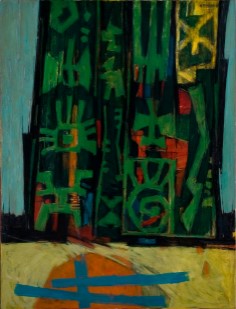
Hale Woodruff, Landscape Black and White, 1967
Audio Recording
Hale Woodruff
American, 1900–1980
Landscape Black and White, 1967
Oil on canvas
Spelman College Purchase

Emma Amos, 2/4 Time, 1984
Audio Recording
Emma Amos
American, 1937–2020
2/4 Time, 1984
Mixed media
Spelman College Purchase
The sociopolitical significance of color was a primary concern for Emma Amos, who started out as a painter and printmaker in her home city of Atlanta but began to incorporate collage and weaving into her practice while working in New York City. “Every time I think about color, it’s a political statement. The terms used in describing painting have always held a double meaning for me,” Amos declared in a 1989 interview. She paid particular attention to the ways in which applying color to canvas or paper could address the visual complexities of race and gender. 2/4 Time is one of many multimedia compositions by Amos featuring women participating in everyday activities. The two figures sit close to one another, so at ease in each other’s company that their bodies blend together. Her values also led her to become an advocate for other Black women artists and to participate in several feminist collectives including the Guerilla Girls, which began protesting the marginalization of women artists by art institutions in 1985.
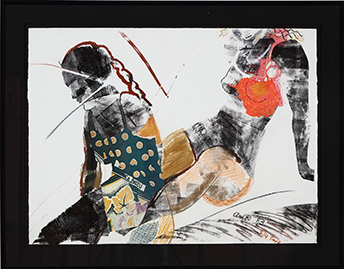
Floyd Coleman, Growing up Black, 1966
Audio Recording
Floyd Coleman
American, 1939–2018
Growing up Black, 1966
Oil on canvas
Spelman College Purchase
Floyd Coleman’s amorphous portrait embodies an uncomfortable yet compelling tension between realism and abstraction. The figure’s jet-black head is animated by simple facial features that give very little indication as to what their emotional state might be. The title provides some insight into Coleman’s thought process while working on this painting in 1966. Perhaps he was considering his own experience as a child in rural Alabama or addressing the collective experiences of Black Americans in the transformative years of the Civil Rights Movement. Coleman had always considered himself to be an artist invested in “Black images,” but it was in 1966 that he decided to make art that was overtly political, while living in Atlanta and working in an art studio on the Spelman campus. “I felt that I did not have the luxury to create esoteric abstractions,” he explained. “I felt I needed to paint works that screamed.” Coleman was also an art historian who played a significant role in shaping the field of African American art history. In 1987, he became the inaugural chair of the Department of Fine Arts at Howard University, where he diligently worked to bring awareness to Black artists who had been overlooked and erased in previous scholarship.
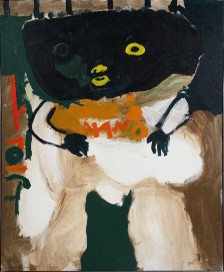
Section Topic: Early Figuration
Audio Recording
Early Figuration
The Spelman College Museum of Fine Art collection includes a wide range of paintings, sculptures, and prints that center around representations of the figure. The artists were frequent participants in conversations surrounding political activism and the artist’s role in society. The earliest work in Silver Linings is a history painting by Henry Ossawa Tanner titled Christ and His Disciples Before the Last Supper, which he completed in 1909, while living in Paris. Several artists were affiliated with the art movements in the United States, known as the Harlem Renaissance and the Black Arts Movement, in which dynamic debates surrounded depictions of Black people in art. There were differences
in opinions on what forms of visual representation empowered Black communities, while reflecting on the injustices they continued to face. These conversations fostered creative environments in cities across the country. Working in Jamaica, sculptor Edna Manley was pivotal in cultivating a more diverse cultural scene and establishing a national image that honored Jamaicans of African descent. As is made clear in this exhibition, there is no one representation of the Black figure that speaks to all Black experiences. Instead, each work provides a unique artistic perspective on the body in space.
Henry Ossawa Tanner, Christ and His Disciples Before the Last Supper, 1908–1909
Audio Recording
Henry Ossawa Tanner
American, 1859–1937
Christ and His Disciples Before the Last Supper, 1908–1909
Oil on canvas
Gift of Catherine and Chauncey Waddell
Henry Ossawa Tanner’s Christ and His Disciples Before the Last Supper is a riveting religious painting created by he artist while he was living and studying art in Paris. Born in Pittsburgh, Tanner began his career in Philadelphia, where he became known for his paintings that feature the domestic life of Black families. Several years after moving to Paris in 1891, he began painting biblical scenes with what he considered to be a “human touch” that made them accessible to contemporary audiences. This turn to religious subject matter was influenced by Tanner’s childhood as the son of a bishop in the African Methodist Episcopal Church and several trips he made to the Holy Land, between the eastern bank of the Jordan River and the Mediterranean Sea. Tanner paid close attention to the interplay between light and color and emphasized illumination as a symbol of holiness in his biblical paintings. He was also an important figure among the Black American artists who traveled to France for training, acting as a mentor to younger painters including Hale Woodruff.

Herman “Kofi” Bailey, Lady with a Banjo, ca. 1960
Audio Recording
Herman “Kofi” Bailey
American, 1931–1981
Lady with a Banjo, ca. 1960
Conté crayon on paper
Gift of Nancy A. Hodgson
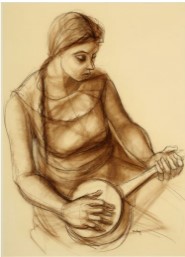
Herman “Kofi” Bailey, Building, 1967
Audio Recording
Herman “Kofi” Bailey
American, 1931–1981
Building, 1967
Charcoal on paper
Spelman College Purchase
Herman “Kofi” Bailey viewed the world through a Pan-Africanist lens, advocating for solidarity between African people and people of African descent living across the African Diaspora. He described himself as a “representational” artist committed to creating “art which tries to express the varying moods of man,” and his charcoal drawings depict Black Americans participating in everyday tasks such as manual labor. In Building, men hard at work in a factory setting are brought to life through Bailey’s expressive use of contouring and shading. He made the illustration the same year that he participated in the Atlanta University Center Artist-in- Residence program and Spelman College hosted an exhibition of his drawings. Bailey was a prominent member of Atlanta’s Black artist community and became involved in the city’s branch of the Student Nonviolent Coordinating Committee. He worked as a poster designer and newsletter illustrator for the organization, which upheld the core values of the Civil Rights Movement through nonviolent protest.
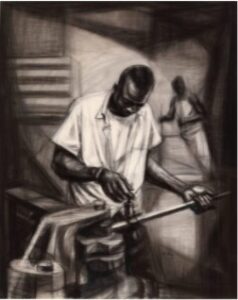
Sam Gilliam, Cozy, 1979
Audio Recording
Sam Gilliam
American, 1933–2022
Cozy, 1979
Acrylic on canvas
Gift of Dorothy Gilliam
Sam Gilliam once stated that he used “painting as an idea, not a subject,” which allowed him to embrace improvisation when creating abstract compositions like Cozy. The artwork consists of two unconventionally shaped canvases that Gilliam intentionally left unframed, and marks from his palette knife add to the textured appearance of each surface. The sharp edges of the differently colored sections make it clear that he utilized more than one painting technique to achieve this level of visual complexity. Gilliam began painting on geometrically shaped canvases in the 1960s with a spontaneity akin to Jazz music, which he has cited as an important point of inspiration. Even though Gilliam described himself as an “abstractionist” who paid particular attention to the formal qualities of painting, he did not view his work as separate from the world around him. Rather, he noted that “the expressive act of making a mark and hanging it in space is always political. My work is as political as it is formal.”
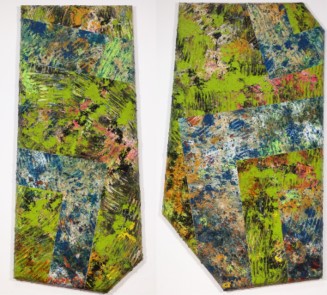
Lucille Malkia Roberts, Out of the Blues, 1983
Audio Recording
Lucille Malkia Roberts
American, 1927–2004
Out of the Blues, 1983
Acrylic and oil on canvas
Spelman College Purchase
Lucille Malkia Roberts once described Out of the Blues as “closer to me emotionally than anything I’ve ever done,” and, “the most major piece which confirms my identity.” Roberts chose to express her internal self through abstraction, with layers of geometric shapes and swirling brushstrokes. She paid particular attention to texture and sought to “emphasize the depth and luminosity of light.” The title of the painting also implies that she was influenced by Blues music and that rich melodies might be found in the various shades of blue. The exploration and freedom embodied in the composition not only speak to her identity as an artist, but also to her work as a teacher. Roberts taught in the renowned Howard University Art Department where she initially studied as an undergraduate student. She committed her life to the development of young Black artists as well as the growth of her own artistic practice.
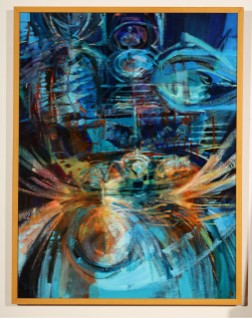
Lucille Malkia Roberts, Winter Sun, 1994
Audio Recording
Lucille Malkia Roberts
American, 1927–2004
Winter Sun, 1994
Watercolor on paper
Spelman College Purchase
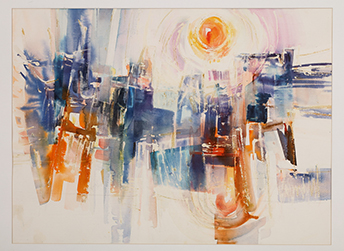
Selma Burke, Sadness, 1970
Audio Recording
Selma Burke
American, 1900–1995
Sadness, 1970
Bronze
Bequest of Selma Burke
Born in North Carolina, Selma Burke developed an interest in sculpting at a young age and went on to become an important participant in the Harlem Renaissance of the 1930s and 1940s. While enmeshed in the thriving artist community of New York City, she focused on creating emotive sculptures of both everyday people and well-known individuals, like the author and orator Booker T. Washington, and President Franklin Delano Roosevelt. (Her portrait of FDR was the uncredited basis for his image on the dime.) Burke was very intentional in her approach to sculpting and noted that she often “completed the piece mentally before attacking the material.” She worked with several mediums including marble, wood, and bronze as seen in the small figure Sadness. When Burke was still a student herself, she began translating her skills into teaching and went on to establish several art institutions including the Selma Burke School of Sculpture in 1946. Spelman College celebrated Burke’s many accomplishments by awarding her an Honorary Doctorate in 1988, and the College has taken a key role in safeguarding her legacy by housing her personal papers in its archives.
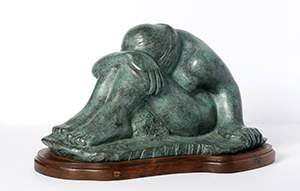
Beverly Buchanan, In the Garden, the Artist at Home, 1993
Audio Recording
Beverly Buchanan
American, 1940–2015
In the Garden, the Artist at Home, 1993
Mixed media drawing
Gift of Lucinda and Robert Bunnen

Beverly Buchanan, Untitled, n.d.
Audio Recording
Beverly Buchanan
American, 1940–2015
left:
Untitled, n.d.
Metal, paint, wood
right:
Untitled, n.d.
Metal, paint, wood
Gifts of Lucinda and Robert Bunnen
Inspired by the Southern vernacular architecture of her childhood, Beverly Buchanan first conceptualized her “shack sculptures” while living in the Bronx in the late 1970s. She drew on her memories of traveling across North and South Carolina with her father and seeing the small homes and tobacco barns owned by the Black farmers who lived there. After moving to Macon, Georgia in 1983, she began photographing similar houses built with reclaimed materials. These photographs served as additional inspiration for sculptures that she constructed out of corrugated cardboard, foam core, paper, tar, metal, and various types of wood. She was particularly interested in buildings that seemed to visually mirror their residents. “I’m making portraits of a family or person which may recall individuals or families I have met,” she explained. When Buchanan was a child, the dwellings that inspired her sculptures were commonplace, but they began to disappear from the landscape as she grew older due to a complex combination of factors including a changing economy. These sculptures artistically document and memorialize a form of Black living that is less visible today but not forgotten.
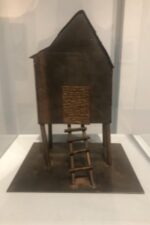

Nellie Mae Rowe, Untitled, 1981
Audio Recording
Nellie Mae Rowe
American, 1900–1982
Untitled, 1981
Pastel, graphite, and marker on paper
Born in Georgia and raised in Virginia, Nellie Mae Rowe’s childhood was shaped by her creativity. She would begin each day picking cotton in the fields with her family and end it by drawing or making dolls out of discarded clothing. Her parents encouraged her growth as a burgeoning artist, and Rowe drew inspiration from observing how her mother stitched quilts and her father wove baskets. As a self-taught artist, Rowe developed a vibrant practice based on her memories of Southern farm life and endless imagination. “I draw what is in my mind. I draw things you haven’t seen born into this world,” she said when describing the fantastical creatures and people that populate her colorful drawings. In adulthood, Rowe continued to make dolls, and she also developed a technique for constructing figurative sculptures out of chewing gum. Her garden was full of homemade tree ornaments that reflected her free-spirited nature and unique artistry.
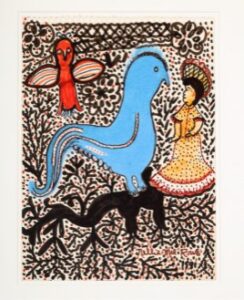
Faith Ringgold, Groovin’ High, 1986
Audio Recording
Faith Ringgold
American, 1930-2024
Groovin’ High, 1986
Acrylic, beads, dye, and sequins on quilted fabric
Gift of Barbara and Ronald Balser
A crowd of exuberant dancers moves across the quilted surface of Faith Ringgold’s Groovin’ High. The vibrancy of their steps is visible in the bright colors, beads, and sequins that visually reflect the fast-paced notes of musician Dizzy Gillespie’s trumpet. The title directly references Gillespie’s 1945 bebop song by the same name, which Ringgold recalls hearing at the famous Savoy Ballroom in Harlem, where she grew up. She began making quilted compositions in the early 1980s, drawing on her knowledge of quilt-making techniques, passed down through the women in her family for generations. The quilts she observed her mother making were rooted in a history of Black quilting traditions dating back to enslavement, when African people and their descendants created quilts out of clothing as a means of survival and artistic expression. Ringgold also looked to other sources while deciding how to craft her multi-layered works of art, and initially learned how to paint on fabric by studying Tibetan thangkas. When asked why she began quilting stories and scenes from her life, Ringgold explained, “I decided I wanted to tell my story…This is my story, and I feel that freedom of speech is very important. I’m determined to have it.”
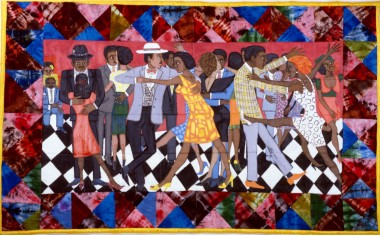
Betty Blayton, Vibes Penetrated, 1983
Audio Recording
Betty Blayton
American, 1937–2016
Vibes Penetrated, 1983
Acrylic on canvas
Spelman College Purchase
Betty Blayton referred to her paintings as “spiritual abstractions” and thought deeply about the viewer’s experience when standing in front of them. For Blayton, creating art had two primary purposes, “The first is personal because the act of creating artworks allows me the opportunity for meditation and self-reflective thoughts related to life’s mysteries and the meaning of being and becoming. The second is hopefully to provide my viewers with opportunities to also engage in meditation and self-reflective thought.” Conversations with her father as a child inspired Blayton to explore mythological and mystical themes that were further influenced by her studies of spiritualism in several cultures. The circular canvas she used in Vibes Penetrated symbolizes the cyclical nature of life and provides a platform for introspective journeys. In addition to her artistic practice, Blayton was also a prominent cultural organizer in Harlem, where she co-founded the Children’s Art Carnival and The Studio Museum in Harlem in 1968.
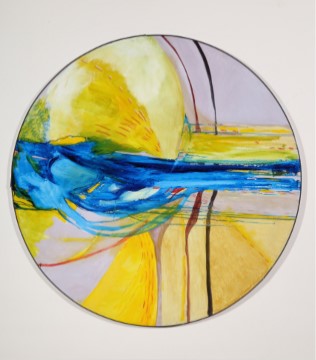
Elizabeth Catlett, Standing Woman (Woman Walking), 1987
Audio Recording
Elizabeth Catlett
American and Mexican, 1915–2012
Standing Woman (Woman Walking), 1987
Bronze
Gift of Drs. William and Camille Cosby
Many of Elizabeth Catlett’s sculptures and prints center around the lived experiences of Black women like her. “We can learn from Black women,” Catlett pronounced in a 1981 interview. “They have had to struggle for centuries. I feel that we have so much more to express and that we should demand to be heard and demand to be seen because we know and feel and can express so much, contribute so much aesthetically.” She cultivated her artistic techniques by studying numerous sources, including West African sculpture and Mexican printmaking. In 1946, Catlett and her first husband, artist Charles White, traveled to Mexico City to learn from the renowned socialist printmaking collective
Taller de Gráfica Popular, or the People’s Graphic Workshop. Not long after the trip, she decided to make a permanent move to Mexico, and, in 1962, she became a Mexican citizen. That same year, the United States government labeled her an “undesirable alien,” accusing her of being affiliated with the Communist Party and barring her from entering her birth country—a ban that lasted nearly 10 years. Nevertheless, Catlett continued to produce work centering Black Americans and the Black Power Movement’s message of community empowerment.
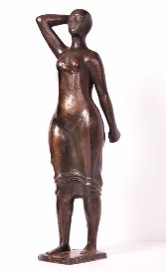
Section Topic: Abstraction
Audio Recording
Abstraction
A diverse array of artworks focused on abstraction feature artists experimenting with form, material, texture, process, and more. Those who worked in the 20th century were at the forefront of discussions concerning abstraction in urban centers, including Atlanta, New York City, and Washington, D.C. They pushed against limitations of traditional understandings of art and often embraced improvisation as a path to innovation. In discussions about 20th century art by artists of African descent in the United States, there is frequently a false dichotomy created between abstraction and realism. Debates surrounding the value of abstract versus figurative art are more nuanced than art history textbooks lead readers to believe. Many of the artists featured in Silver Linings were continually experimenting with both abstraction and figuration, pushing the boundaries of what was considered socially acceptable for Black artists to create. In the 21st century, these conversations have multiplied as artists continue to challenge stereotypical notions of “Black art” as it has been historically defined in the United States.
Carrie Mae Weems, I Looked and Looked and Failed to See What So Frightened You, 2004
Audio Recording
Carrie Mae Weems
American, b. 1953
I Looked and Looked and Failed to See What So Frightened You, 2004
C-print diptych
Purchased with support from Frederick and Suzanne Burks in support of the 15 x 15 Acquisitions Initiative
In this diptych, Carrie Mae Weems presents a self-portrait and its flipped image. Weems wears a quilted dress and gazes into a handheld mirror as if reflecting on the words of the poem she penned to accompany the piece. It begins with the following stanza:
While I knew nothing, not the contours of your mind or the vast scope of your machinations
or the ordering of your society
but I saw its codes; its designs & its symbols reflected everywhere
Weems created these photographs as part of a larger body of work known as the Louisiana Project commissioned by the Newcomb Art Gallery at Tulane University. The project delves into the lasting cultural impact of the Louisiana Purchase of 1803, when the United States acquired land stretching from present-day Montana to Louisiana—much of it home to Native American nations—from the French First Republic. She identifies the coded imagery of Louisianan society and makes it visible through objects like her dress, which can be linked to the quilting traditions of enslaved Black communities. From the entrenched history of enslavement to the celebratory evolution of Mardi Gras, Weems’s Louisiana Project captures the complex formation of the history and culture of New Orleans, where the project originated.

Renee Cox, Hot-en-Tot, 1994
Audio Recording
Renee Cox
American, b. Jamaica 1960
Hot-en-Tot, 1994
Gelatin silver print
15 x 15 Acquisitions Initiative Purchase
When Renee Cox photographed herself wearing a pair of plastic breasts and buttocks tied to her body, she did so with the intention of becoming an avatar for Saartjie Baartman (ca. 1789-1815)—a Khoikhoi woman from the contemporary region of the Eastern Cape in South Africa who was coerced into being publicly exhibited in Europe as the “Hottentot Venus,” from 1810 until her death. Cox looks over her shoulder toward the viewer to, in her words, create a “triumphant moment” in which Baartman is able to “return the gaze” of those who exploited her. British and French audiences paid to stare at Baartman, who was presented as a specimen with an unusually large buttocks. Napoleon Bonaparte’s Surgeon General Georges Cuvier argued that her appearance was more animal than human, and after her death, he dissected Baartman’s body for pseudo-scientific research intended to prove the superiority of the white race. Cuvier preserved her organs and made a cast of her body that remained on display at a museum in Paris until 1974. It was not until 2002 that Baartman was returned to South Africa and respectfully buried.
Hot-en-Tot is one of many photographs in which Cox centers her own body to construct what she describes as a “revisionist history” that empowers Black womanhood. Costumes and props allow her to embody historical figures and fictional personas. When Cox found these prosthetics in a Halloween store, she made a connection between their oversexualized appearance and the distorted way that cartoonists depicted Baartman in 19th century newspapers. Baartman was treated with incredible cruelty in life and death, but through Hot-en-Tot Cox creates a fictional platform in which she can reclaim her story.

Section Topic: Contemporary Photography
Audio Recording
Contemporary Photography
The invention of photography expanded the realm of artistic possibilities for Black artists. As photography became more widely available during the 19th century, Black photographers invited their communities into photography studios where they could curate new forms of self-representation. Scholar and Black feminist activist bell hooks has written extensively about the camera as a powerful tool that challenges class boundaries and allows Black people to take control of the production of their image, from start to finish. This history continues to influence contemporary art. Carrie Mae Weems, Renee Cox, and Myra Greene center their own bodies in photography to reflect on positive and negative representations of Black figures of the past. Other artists take different approaches. Lorna Simpson modifies archival photographs, while Glenn Ligon analyzes a blurred image from a diagrammatic perspective.
Lorna Simpson, Details, 1996
Audio Recording
Lorna Simpson
American, b. 1960
Details, 1996
Portfolio of 21 photogravures with text
Purchase made possible by Friends of the Museum in support of the 15 x 15 Acquisitions Initiative
Details includes 21 archival photographs that can be exhibited in a variety of arrangements. Lorna Simpson cropped each image so that hands become the central point of focus and added accompanying captions that provide potential clues as to the identities of the individuals whose faces are no longer visible. Simpson applies the term “photo-text” to the combination of words and images that she frequently uses in her practice. Her process of visual and linguistic fragmentation encourages an ambiguous reading of works like Details. By fracturing any semblance of linear storytelling, she opens a conversation about the ways individuals attempt to present themselves through photography and the ways, in turn, society perceives them. What characteristics and personality traits can be learned from each hand gesture? What might the descriptions “half learned” and “indifferent” tell us about the adults and children brought together on this wall? These are questions that each viewer will answer differently depending on the contextual information they bring with them.
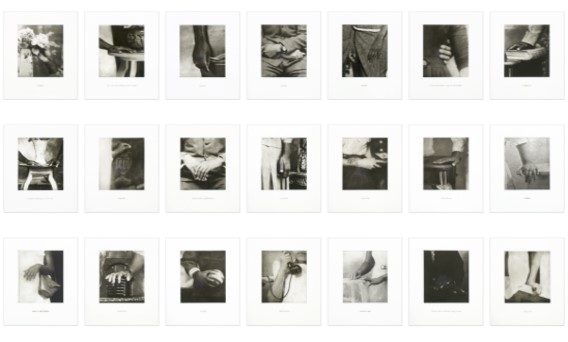
Glenn Ligon, Untitled, 2003
Audio Recording
Glenn Ligon
American, b. 1960
Untitled, 2003
Photogravure etching
Gift of the Peter Norton Family Foundation
Glenn Ligon constructs complex dynamics between images and texts that engage with a range of themes including race, sexual orientation, and histories of oppression. He considers language to be a “material” in itself, and he frequently references historically significant pieces of writing. In this etching, Ligon presents a photo-micrograph—or a microscopic photograph—of paint, accompanied by quotes from three 20th-century novels. Photo-micrography is an important technique in painting conservation that provides insight into how and when a painting was made. There is an intentional ambiguity in Ligon’s use of photo-micrography, and the literary excerpts take on new meaning when brought together in this format. The first quote comes from German author W. G. Sebald’s novel The Rings of Saturn, published in 1995; the second is emblematic of Japanese writer Yukio Mishima’s novel Confessions of a Mask, completed in 1949; and the third is sourced from Virginia Woolf’s experimental novel The Waves, from 1931. These different entry points create a layered viewing experience that moves beyond conventional presentations of photography.
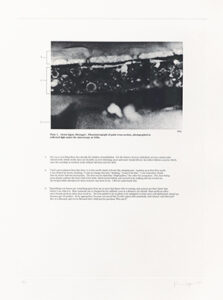
Myra Greene, Character Recognition, 2004–2007
Audio Recording
Myra Greene
American, b. 1975
Character Recognition, 2004–2007
Ambrotype on black glass
15 x 15 Acquisitions Initiative Purchase
“Confronted with an up swell of bigotry both personal and public, I was forced to ask myself, what do people see when they look at me. Am I nothing but black? Is that skin tone enough to describe my nature and expectation in life?”
In Character Recognition, Spelman Professor Myra Greene interrogates the lingering influence of ethnographic classification. Nose, mouth, eye—Greene asks if society sees her as a human being or a compilation of racialized body parts. She created these strikingly cropped images of her face with the ambrotype process in which an image is produced by placing an underexposed glass negative against a black backdrop, resulting in a positive image. A popular form of photography in the mid-19th century, white ethnographers used ambrotypes to document the appearance of Black individuals. They sought to establish a racial hierarchy through an interpretation of physical features that placed people of African descent at the bottom. Greene encourages viewers to consider how this legacy lives-on in the ways that Blackness and Black people are perceived today.

Carrie Mae Weems, Color Real and Imagined, 2014
Audio Recording
Carrie Mae Weems
American, b. 1953
Color Real and Imagined, 2014
Archival inkjet print with silkscreen color blocks
Gift of Laurel Shackelford
Solid blocks of color partially obscure a blurry portrait in Carrie Mae Weems’s Color, Real and Imagined. The title speaks to the complexity of the Black experience in American society and the racism people face based on the color of their skin. Weems confronts police violence against Black individuals fueled by negative stereotypes that date back to the enslavement of African people. Colonizers and enslavers fabricated racial hierarchies to justify the subjugation of people of African descent, and these falsehoods stripped away their individuality. In her series The Usual Suspects, Weems not only brings attention to the murder of Black people by law enforcement, but also to the inequities within the justice system when it comes to holding accountable those responsible. When speaking about the intention behind her artistic practice, Weems explains that she is invested in “getting rid of the stereotype so that [a] person’s humanity shines through.”

Lina Iris Viktor
Audio Recording
Lina Iris Viktor
Liberian-British, b. 1987
left – right:
Our Re-memories – sheer acts of Rebellion, 2019
Pure 24-karat gold, acrylic, gouache, ink, print on cotton rag paper
For a time we hid from ourselves. Our Dark Testament., 2019
Pure 24-karat gold, acrylic, gouache, ink, print on cotton rag paper
After the Long Sleep we now Wake…, 2015–2019
Pure 24-karat gold, acrylic, gouache, ink, print on cotton rag paper
We are the Night – The Keepers of Light, 2015–2019
Pure 24-karat gold, acrylic, copolymer resin, ink on cotton rag paper
Museum Purchases made possible by Friends of the Museum
These dreamlike tableaux are part of Lina Iris Viktor’s larger series titled The Dark Continent, in reference to the imperialist term European colonizers once used to describe Africa. Here, Viktor remakes the dangerous unknowability of “The Dark Continent” into something divine with 24-karat gold leaf details. Gold holds what Viktor refers to as an “otherworldly” spiritual value that empowers the Blackness of her mythological landscapes. Each composition contains a complex cosmology comprised of several cultural references, including West African sculpture, European portraiture, and Egyptian iconography. The pitch-black paint that Viktor applied to her skin forms a connection between the color black and the concept of Blackness. The multi-layered significance of Blackness includes the experiences of Black people and the ways that Black people have been perceived throughout history.
Viktor seeks to counter the negative connotations sometimes associated with Blackness, such as impurity and ugliness. When discussing the symbolism behind her use of the color black, she explains, “When you look into the sky it looks black to the human eye, it looks like a void, but it’s full. Dark matter has substance.” Like the sky, Blackness is full of expansive possibilities.
Deborah Roberts, Grillz, Not on Me, 2017
Audio Recording
Deborah Roberts
American, b. 1962
Grillz, Not on Me, 2017
Mixed media on paper
Museum Purchase made possible by Friends of the Museum
Flower petals, tiaras, glinting silver teeth, and other adornments are layered on top of photographs of Black children in Deborah Roberts’s Grillz, Not on Me. The result is a group of complex portraits that Roberts describes as embodying the “social pressures and projected images” that young Black people encounter in their everyday lives. Each face is a composite of photographic images that she collected from the internet, magazines, and other sources. Through collage, she makes space for personal discovery and experimentation while also challenging the often-unquestioned emphasis on whiteness in historical representations of beauty. Her figures encourage viewers to recognize how Black bodies have been “othered” in Western European art history, and to consider what changes need to be made in the contemporary art world for more inclusive ideas of beauty to emerge. Roberts believes that even with outside forces attempting to influence each child’s sense of self, they have the “character and agency to find their own way.”

Benny Andrews, From the Mountain Top, 1999
Audio Recording
Benny Andrews
American, 1930–2006
From the Mountain Top, 1999
Oil and collage on paper
Gift of the Benny Andrews Estate and Foundation by courtesy of the UNCF for the purpose of encouragement of African American museums and educational institutions in their missions
Benny Andrews, Fun #2, 2002
Audio Recording
Benny Andrews
American, 1930–2006
Fun #2, 2002
Oil and collage on paper
Gift of the Benny Andrews Estate and Foundation by courtesy of the UNCF for the purpose of encouragement of African American museums and educational institutions in their missions
In a cozy room, filled with light and color, a couple dances joyfully, while a young child immersed in a task, leans over a table. This domestic scene is one of many painting-collages celebrating Black life, that Benny Andrews created during his career. “We are entitled to have representations of people that look like us and talk and feel like us,” he once said while speaking about what drove him to make art intended for his community. For Andrews, it was essential that Black artists could explore whatever subject matter they wished, unrestricted by societal expectations. His own art encompassed an array of themes from familial bonds to the racial discrimination of Black people in the United States. In 1969, his commitments to representation and freedom of expression led him to co-found the Black Emergency Cultural Coalition, which demanded that Black artists be included in exhibitions held in New York City museums. Their protests led to crucial changes in the art world that reverberated across the country.

Benny Andrews, Sunrise, 2005
Audio Recording
Benny Andrews
American, 1930–2006
Sunrise, 2005
Oil and collage on paper
Gift of the Benny Andrews Estate and Foundation by courtesy of the UNCF for the purpose of encouragement of African American museums and educational institutions in their missions
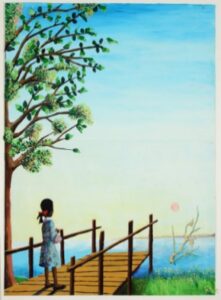
Samella Lewis, Mother and Child, 2007
Audio Recording
Samella Lewis
American, 1923–2022
Mother and Child, 2007
Lithograph
“My inspiration as an artist and art historian comes from the need to bring greater attention to the accomplishments of African American Artists.” This was the approach by which Samella Lewis pursued her multi-faceted career as a printmaker, painter, sculptor, and writer. Lewis was frequently the first person to document and elevate the careers of fellow Black artists while simultaneously crafting her own artistic practice. She began her career studying under the tutelage of Elizabeth Catlett at Dillard University, where she embraced themes related to Black life including domestic scenes that evoked a strong sense of kinship and love. In this lithograph, titled Mother and Child, she portrays the intimacy between the two figures through the softness of their expressions and the warmth of the color palette. Lewis explored the same subject across multiple mediums and even sculpted a monumental mother and child statue while continuing her studies at Hampton University. The sculpture was too large to move when she graduated, so Lewis decided to destroy it rather than abandon or sell it. For Lewis, her creation was something to be cherished and she treated the work of other Black artists with the same level of respect.
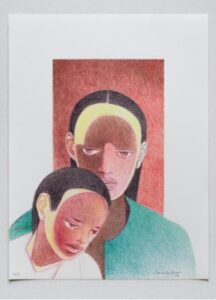
Firelei Báez, Of Love Possessed (lessons on alterity for G.D. and F.G at a local BSS), 2016
Audio Recording
Firelei Báez
American, b. Dominican Republic 1981
Of Love Possessed (lessons on alterity for G.D. and F.G at a local BSS), 2016
Acrylic on Yupo paper
Purchased with support from Wish Foundation, Inc. and Drs. Sivan and Jeffery Hines in celebration of the Museum’s 20th Anniversary
This hybrid figure, covered in fur and delicate flowers, is known as a ciguapa—a creature that Firelei Báez describes as a trickster and seductress in Dominican mythology. The history surrounding the ciguapa is ambiguous, but it is often described as having the appearance of a woman with feet pointed backwards to symbolize its opposition to societal interpretations of good moral behavior. Báez is particularly drawn to the ciguapa because the myth allows her to reframe stereotypically negative feminine characteristics “as something beautiful and with an eye of desire.” There is a freedom in the untamable nature of the ciguapa that Báez views as deeply powerful. “In reading my paintings of ciguapas, I’m asking the viewer to come to terms with their own feelings around a woman’s body,” she explained in 2022. Her perspective is also informed by colonial histories of the Caribbean, including the illustrations of Indigenous flora and fauna produced by 16th-century European botanists. Though rife with error, embellishment, and pseudo-science, these taxonomic drawings were used as tools to document and subjugate the “New World.” Báez’s paintings are counternarratives to this history in which flowers grow unrestricted by colonization.
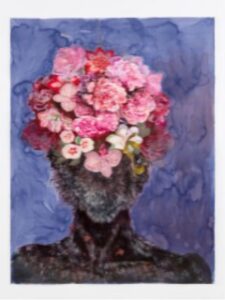
Howardena Pindell, Untitled #49, 2012
Audio Recording
Howardena Pindell
American, b. 1943
Untitled #49, 2012
Mixed media on board
Purchased with support from Elynor A. Williams in honor of her mother, Naomi Douglass Williams
Howardena Pindell’s detailed process of deconstruction and reconstruction is on display in her mixed-media composition Untitled #49. The gridded design takes on a three-dimensional quality, with the addition of circles that Pindell created using a hole punch. Some of these circles were cut again, resulting in a variety of shapes. Pindell describes the circle as an “iconic form” found in the cosmos, and her interest in the shape stemmed from her childhood experiences driving through Northern Kentucky with her father. She remembers stopping at a root beer stand, where she received a bottle with a red circle on the bottom, indicating that it was designated for a Black customer as opposed to a white customer. “That form really remained dormant in my mind,” she noted when reflecting on her past. That was until Pindell entered the Master of Fine Arts program at Yale University in 1965 and was inspired to repeatedly use circles in her work. During the 1960s, she also began developing her hole-punch technique and use of the grid with a playfulness that pushed against the simplified appearance of minimalist art that was popular at the time.
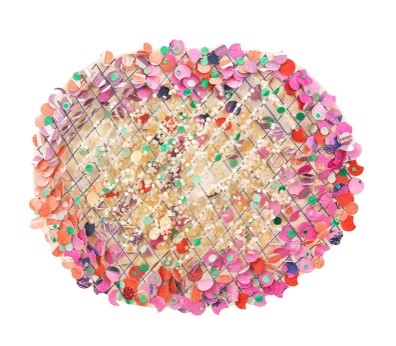
Amalia Amaki, Blue Gold Lady, 2005
Audio Recording
Amalia Amaki
American, b. 1949
Blue Gold Lady, 2005
Color photography
Gift of Paul R. Jones in tribute to his son Paul R. Jones, Jr.
Amalia Amaki once described herself as the “buttons and Blues” artist in reference to her veneration of women Blues singers made apparent in her photography and multimedia works that incorporate found objects. Even when she is working in other mediums, Amaki views her art through a photographic lens and considers photography to be central to the “spiritual experience” of creating art. In the diptych Blue Gold Lady, Amaki pairs two photographs, both focused on a partial view of a woman’s face, with one image seemingly a color negative of the other. She frequently incorporates the color blue into her work as a reference to Blues music, which became intrinsic to Black culture in the American South as early as the 1860s. Her interest in the Blues can be attributed to her father, a singer who encouraged her to cultivate an appreciation for music while she was growing up in the dynamic cultural hub of Atlanta. In her role as an art historian, Amaki has made significant contributions to her home city by teaching at Spelman College and serving as a Scholar-in-Residence at the Spelman College Museum of Fine Art.
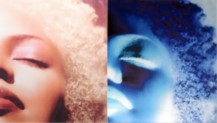
Section Topic: Contemporary Figuration
Audio Recording
Contemporary Figuration
Through painting, photography, collage, and multimedia works, the 20th century artists in the final section of Silver Linings create compelling narratives surrounding figuration. Firelei Báez focuses on the folklore of the Dominican Republic; Lina Iris Viktor creates a mythology drawing from several cultures; Amalia Amaki takes up the camera to capture twin images suspended in time; and Deborah Roberts utilizes collage to give a voice to Black children. Roberts’s Grillz, Not on Me from 2017, is a collage of photographs with interesting visual similarities to the semi-abstract collage by Romare Bearden that is on view in the introductory section of the exhibition. This cross-generational connection between Bearden and Roberts touches on collaging as an innovative technique for many Black artists because of its ability to encapsulate a multiplicity of meanings. The abundance of voices in Silver Linings attests to the diversity of lived experiences and artistic perspectives that are present within a collection of art dedicated to artists of African descent.

